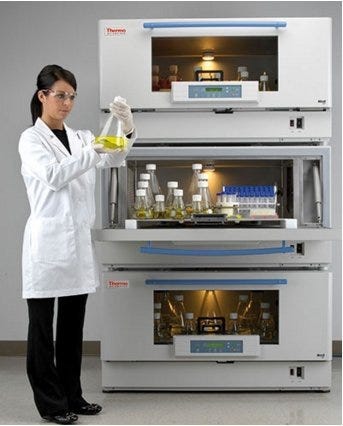Instrument options abound for preparing, incubating, washing, or chemical fixation of samples using kinetic motion. Lab mixers that include orbital shakers, vortexes, rockers, rollers and rotators are all offered in a variety of configurations (capacity, speed, duration, slope and more). These common lab instruments have been a necessary component of basic experimentation and sample preparation for decades; almost as long as chemists have understood the impact of motion.
The diversity of these mixing instruments is second only to the media and containers with which they are used. Thus, one must consider not only the procedure being performed, but also the nature of the samples used. Here we discuss this equipment and their most common applications to assist you in selecting the correct solution.
What are these instruments?
Orbital Shakers & Vortexers
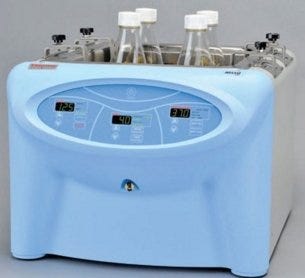
MaxQ™ 7000 Water Bath Orbital Shaker from Thermo Scientific
Orbital shakers rotate along two planes parallel to the work surface. Occasionally, manufacturers incorporate a third range of motion, such that they reciprocate. This orbital feature allows for enhanced distribution of low-volume samples. These units are ideal for bacterial cell growth, dissolution studies, and staining of electrophoresis gels and blots. These units typically accommodate microcentrifuge tubes, microplates, and gel trays, in addition to larger Erlenmeyer flasks.
Use the higher speed orbital shakers for bacterial incubations. These specialized shakers keep cells in suspension, providing optimal growth conditions. For small-scale bacterial growth studies, shakers with small footprints can often be placed within an incubator to promote growth. With larger bacterial cultures, a water bath shaker can be used, accommodating several large flasks simultaneously. These water baths provide more efficient thermal heat transfer for rapid heating and low spatial deviation compared to similarly priced forced-air incubators.
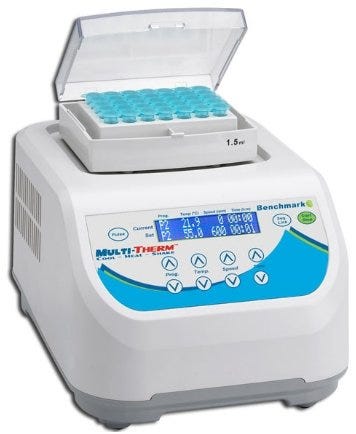
Benchmark Scientific Multi-Therm™ Vortexer
Vortexers differ from shakers in that they move in a circular motion. When tubes come in contact with the pad, the motion is transferred to the liquid, which eventually forms a vortex. They are good for mixing and cell suspension, and offer speed and uniformity versus trying to do it manually. Many also offer temperature control.
Rockers
As the name might indicate, rockers were designed to mix by gently swaying back and forth. They can typically accommodate the same range of tubes, plates and blot trays as mentioned above. The purpose of rockers is to provide extremely low level agitation, unlike the more aggressive motion from shakers. For example, when chemically fixing tissues for incubation, it is of paramount importance not to disrupt the tissue while it is being fixed.
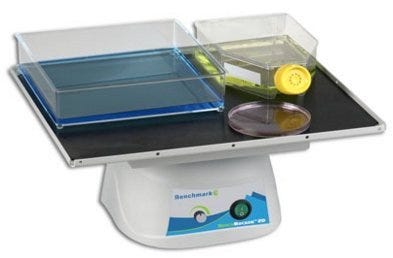
BenchRocker™ 2D Variable-Speed Rocker by Benchmark Scientific
Additionally, rockers are used during blotting applications. For Western blot protein analysis, fragile membranes need careful handling, or you risk having to repeat the experiment. Also when blocking membranes, the slow rocking motion provides very little kinetic activity, allowing your blot to properly adhere. Whether fixing, blocking, or incubating tissues, cells, or blots, a rocker is best suited to your application.
Rotators
Laboratory rotators offer circular motion around an axis. Traditional rotators were arranged along the plane of the work surface. This axis was then used for rotation of samples. More recently, manufacturers have begun to design these rotators in a wheel orientation, which provides better force and sample dispersion since it has a 360° rotation for each sample. The gentle end-over-end movement provides excellent mixing with minimal sample disruption. Some salient applications include dissolving cell pellets and mixing laboratory reagents into solution.
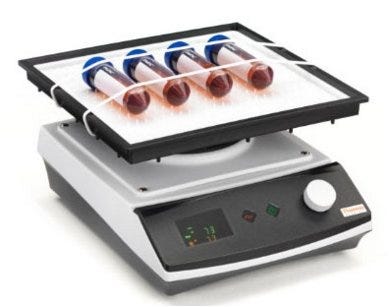
Compact Digital Waving Rotator by Thermo Scientific
Rollers
Tube rollers were designed for gentle mixing of collection or conical tubes. For best diagnostic results, a sample needs to be adequately blended with the preservative or stabilizer added to, or lining, the tube. These rollers are designed to hold specimen tubes in a stationary horizontal position for rotation between rotors. They are ideally suited for clinical laboratories, medical research, and physician offices, where risk of a spilled tube could be hazardous.
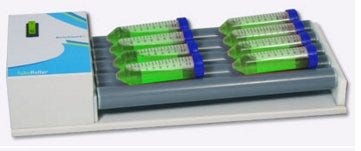
TubeRoller Tilting Roller (for bottles and tubes) by Benchmark Scientific
The best choice?
Like other equipment you bring into your lab, application goals, as well as sample size, type and volume, need to be considered when making choices. You wouldn’t use a high-speed shaker to prepare a blood draw for analysis, for example, as the physical response to motion will likely cause erroneous results. Figure out what direction and speed of motion is ideal for the samples types you process, as well as your desired equipment features. For more information about these kinetic helpers, visit Laboratory Rockers, Rotators and Rollers from Laboratory-Equipment.com.



